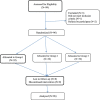Effectiveness of different doses of dexmedetomidine on intraoperative haemodynamic profiles and postoperative pain in patients undergoing abdominal surgery at Dilla University Referral Hospital, Ethiopia, 2024: a double-blind randomized controlled trial
- PMID: 39118723
- PMCID: PMC11305718
- DOI: 10.1097/MS9.0000000000002094
Effectiveness of different doses of dexmedetomidine on intraoperative haemodynamic profiles and postoperative pain in patients undergoing abdominal surgery at Dilla University Referral Hospital, Ethiopia, 2024: a double-blind randomized controlled trial
Abstract
Background and objective: Abdominal surgery stands as one of the most frequently conducted procedures across surgical specialties, accounting for up to half of surgery-related expenses. Hemodynamic instability emerges as a significant concern during anaesthesia and surgery, provoked by the stress of intubation, surgical incision, and anaesthetic agents. Following abdominal surgery, pain is an inevitable consequence, typically managed with opioid-based analgesia. However, the adverse effects associated with opioids often overshadow their analgesic benefits, particularly in the context of abdominal surgery. Consequently, there exists a necessity to explore and assess alternative non-opioid pain management options post-abdominal surgery as part of a broader strategy to reduce opioid usage. The primary aim of this investigation is to assess the effectiveness of varying doses of dexmedetomidine in regulating intraoperative hemodynamics and alleviating postoperative pain in patients undergoing abdominal surgery.
Methods: Ethical clearance and institutional review board were obtained from the ethical clearance committee of Dilla University College of Medicine and Health Sciences with protocol unique number of duirb/008/22-01. Our trial has been prospectively registered on the Pan African Clinical Trial Registry with a unique identification number for the registry PACTR202208813896934. Statistical package and analysis were performed by using SPSS version 25. The distribution of data was checked by using Shapiro-Wilk test and the homogeneity of variance was checked by Levene's test. Analysis of variance (ANOVA) and Kruskal-Wallis H test were used for normally distributed continuous data and non-normally distributed or non-parametric data, respectively. P value less than 0.05 with a power of 90% was considered statistically significant.
Result: There was a statistically significant increase in mean SBP in the control group at the different critical time points (P<0.05), as compared to the baseline value, while there was no significant difference in mean systolic blood pressure (SBP) between the baseline and all other levels for group 2 and group 3. A statistically significant increase in mean arterial pressure (MAP) was detected in the control group at immediately after intubation (P=0.009) as compared to the baseline value, while a statistically significant reduction in mean heart rate (HR) was observed in group 3 at 15th min after infusion and at 30th 30 min after induction compared to baseline with a P value of 0.002 and 0.008, respectively.Conclusion:Perioperative low-dose infusion of dexmedetomidine at the rate of 0.4 mcg/kg/h is a useful anaesthesia adjuvant to control hemodynamic stress response to critical periods. It is wise to use this infusion dose as part of general anaesthesia to achieve better hemodynamic stability.
Keywords: Anaesthesia; Ethiopia; dexmedetomidine; haemodynamic; perioperative; surgery.
Copyright © 2024 The Author(s). Published by Wolters Kluwer Health, Inc.
Conflict of interest statement
Nothing to declare.
Figures



References
-
- Pfuntner A, Wier LM, Stocks C. Most Frequent Procedures Performed in U.S. Hospitals, 2011. 2013 Oct. In: Healthcare Cost and Utilization Project (HCUP) Statistical Briefs [Internet]. Rockville (MD): Agency for Healthcare Research and Quality (US); 2006. - PubMed
-
- Ung JWLJ. Postoperative pain management: Study of patients’ level of pain and satisfaction with health care providers’ responsiveness to their reports of pain. Nurs Health Sci 2003;5:13–21. - PubMed
-
- and ASoAACoS. Parameters P. Practice guidelines for acute pain management in the perioperative setting. An update report by the American Society of Anesthesiologists task force on acute pain management. Anesth Essays Res 2010;116:248–273. - PubMed
LinkOut - more resources
Full Text Sources
